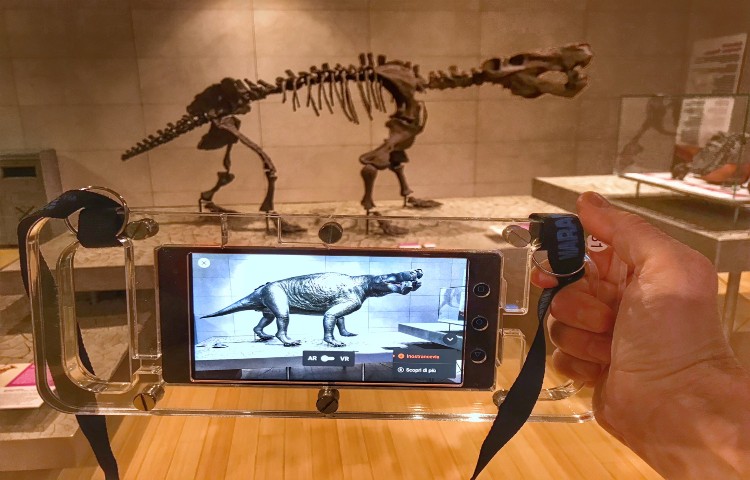

Prefer to listen instead? Here’s the podcast version of this article.
Amidst COVID-19, a worldwide shutdown has impacted retailers for months and possibly years to come. One area retailers may need to be concerned about for the long-term is the decline of consumer in-store traffic even as sites slowly begin to reopen. Reuters recently estimated a 40% drop in daily visits to retail locations compared to this time last year. During these challenging times, however, innovation in technology can provide an alternative, one in particular, is augmented reality (AR).
While virtual reality (VR) immerses a user with a headset into a virtual world with no real world environment, augmented reality is an immersive and interactive experience that resides in the real-world with overlaid computer graphics. AR, in its relation to VR, is more of a mixed reality that is accessed through multiple devices, not just a headset. Augmented reality is one growing technology set to alter the customer experience, both in-store and through e-commerce, in 2020 and the years to come.
Some companies have already accelerated their implementation of augmented reality into their stores and mobile applications. Warby Parker, for example, leveraged their mobile application to offer in-store contactless shopping. As Warby Parker outlets began reopening across the country, shoppers were encouraged to use Warby Parker’s mobile app for an AR-powered Virtual Try-On feature that allowed shoppers to see how a pair of glasses would look on them without having to physically try them on while walking around the store.
Clothing outlets have also been discussing and utilizing augmented reality so customers can continue to find the perfect outfit and still have a sense of knowing if the clothes would be the right fit before making a purchase. This innovation could also significantly improve online sales as a 2020 survey found that 70% of clothes purchased online are returned by shoppers. Instead of struggling over multiple sizes and colors, an AR feature allows consumers to see an image of a specific size or color of clothing on themselves.
Asos is one clothing brand that has started to promote new products by simulating real models digitally fitting clothes. The AR tool had been in development for over a year by Zeekit, but production accelerated with the on-going lockdown. And, in addition to clothing outlets, big beauty brands, such as L’Oreal, are already utilizing a virtual try-on application; and Ikea has been using AR for furniture placement for some time.
Another industry of retailers impacted by COVID-19 is home improvement outlets such as Lowe’s and Home Depot. Lowe’s introduced an AR chat tool powered by Streem, called “Lowe’s for Pro’s JobSIGHT” as part of its $25 million commitment to support small businesses. The application allows Lowe’s employees to run virtual consultations with customers, and augmented reality enables employees to help illustrate repairs customers need, troubleshoot issues, or provide product details. So, for example, without needing to visit a customer’s home for a repair, an employee can use quick-draw tools or on-screen laser pointers to guide a customer on how to complete a simple project themselves.
Many retailers have been able to implement new technology over the past few months quickly; however, some companies are looking even further down the line as life’s new normal may be impacting retailers for years to come.
Facebook, for example, utilizes augmented reality and virtual reality to recreate what remote working might look like in a post-pandemic era. Andrew “Boz” Bosworth, Head of AR and VR at Facebook, recently tweeted a concept video using real footage from prototypes that illustrate what a future work station might look like. Mainly, users would be able to see a mixed reality of interactive floating displays and the room or environment they’re currently working in. This combination of AR and VR is capable through Oculus’ headsets that utilize outward-facing cameras.
This type of innovation creates flexibility for the worker. Instead of getting stuck in the same home office, you can take your office anywhere. Or if you feel as though your productivity drops at home without an extra monitor to work on, you can use multiple displays while wearing a headset.
Microsoft has a similar mixed reality headset of their own that is currently only in development for business use and not consumer ready yet. Their latest version, HoloLens 2, is now equipped with 5G support and, most recently, has helped London hospitals reduce the number of doctors needed to care for COVID-19 patients.
So, while online shopping has been the preferred route for consumers during this time of isolation, perhaps the future of augmented reality involves bringing a more immersive customer experience to any home. With a mixed reality headset, retail technology innovations might soon let anyone turn their living room into the gardening aisle of their closest Home Depot location.
Even with so much uncertainty, the digital and customer experience remains a top priority for retailers. Whether innovation comes through a mobile application or online store, creating an engaging experience will help retailers and consumers thrive during a pandemic and long-term.
Learn more about Quantilus’ work in augmented reality here.
WEBINAR